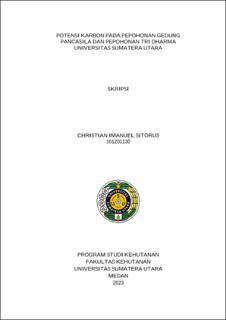| dc.description.abstract | The campus of the University of North Sumatra (USU) located in Padang Bulan Medan is a form of urban green open space that has ecological, social, cultural and aesthetic benefits. The campus of the University of North Sumatra also plays an important role in maintaining urban ecosystems in the city of Medan, North Sumatra. The Pancasila Building trees and the Tri Dharma trees of the University of North Sumatra are a green open space area dominated by treevegetation that grows compactly and densely with an area of around 1.26 ha of Pancasila Building trees and around 1.06 ha of Tri Dharma trees. The research was conducted in January - April 2022 for a period of approximately four months at the Pancasila Building, University of North Sumatra and Tri Dharma, University of North Sumatra. This research was conducted by means of direct surveys to the field with data analysis using "estimation of tree biomass, calculation of tree carbon stocks, calculation of CO2 absorption potential, and statistical t tests". There are 17 species of trees with a total of 191 individuals which are dominated by Mahogany trees (Swietenia macrophylla), namely as many as 154 individuals in the Pancasila Building and There are 8 types of trees with a total number of 297 individuals which are dominated by Mahogany trees (Swietenia macrophylla), namely as many as 277 individuals in Tri Dharma. The method for calculating the aboveground biomass of trees uses selected allometric equations and volumetric methods. The results of this study indicate that based on the volumetric method, the amount of carbon stored in the Pancasila Building, University of North Sumatra, is 107.12 tons/ha. The amount of carbon stored based on the selected allometric equation ranges from 72.54 to 102.32 tons/ha and based on the volumetric method the amount of carbon stored in Tri Dharma University of North Sumatra is 439.93 tons/ha. The amount of carbon storage based on the selected allometric equation ranges from 151.03 to 244.19 tons/ha. Based on the results of the T statistical test between the allometric method and the volumetricmethod in the tree area of the Pancasila building, the results did not have a significant effect, based on the results of the T statistical test between the allometric method and the volumetric method in the Tri Dharma tree area, the results had a significant effect. | en_US |





